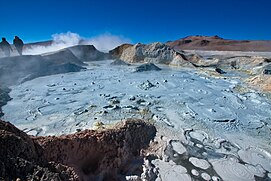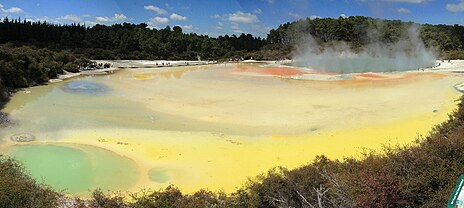Earth:Geothermal activity
Geothermal activity is a group of natural heat transfer processes, occurring on Earth's surface, caused by the presence of excess heat in the subsurface of the affected area.[2] Geothermal activity can manifest itself in a variety of different phenomena, including, among others, elevated surface temperatures, various forms of hydrothermal activity, and the presence of fumaroles that emit hot volcanic gases. Template:ToCTemplate:ToC
Background physics
Geothermal activity mostly appears in volcanic provinces, where it is fueled by the presence of a magma chamber. In some rare cases it can be caused by underground fires or by large deposits of radioactive elements. Other sources of internal heating can be gravitational differentiation of substances, tidal friction, metamorphism, or phase transitions. The release of heat to the surface occurs either in the form of a conductive heat flow, or in the form of convective heat transfer by groundwater or gases.[3]
Types of geothermal activity
Fumaroles and vents
Fumaroles, or volcanic vents, are holes in the ground from which volcanic vapors and gases escape to the atmosphere. Geothermally active areas are often located over an active magma chamber, which constantly releases hot gases that travel to the surface through cavities in the rock. Where these cavities reach the surface they form fumaroles. Areas where these vents are concentrated are known as Fumarole fields. Fumaroles tend to form concentrated deposits of sulfuric minerals, which fall out of suspension when the volcanic gases cool to the air.[4]
Ice cauldrons
Ice cauldrons are a feature that occurs when an ice cap is affected by geothermal heating, either from active volcanism or the continuous heat production from an active geothermal area. Ice cauldrons can have many different appearances. These range from a smooth dent in the ice cap to deep holes with very steep walls formed by concentric rings of crevasses. The width of ice cauldrons can range from 50 meters up to around 10 kilometers, while depth can range from several meters to hundreds of meters. The shape of the cauldron can be stable or highly variable, and is not related to the nature of the underlaying heat source.[5]
Hydrothermal activity
Geothermal heat and groundwater can interact in several ways.
Geysers
Geysers are the most well known hydrothermal feature. they occur when groundwater in underground cavities becomes superheated under a lid of colder surface water. When the superheated water breaches the surface, it flashes to steam, causing the pressure below it to suddenly drop, which causes a chain reaction where most of the water in the geyser's feed system flashes to steam all at once.
There are two main types of geyser. Fountain geysers, which erupt in violent bursts from a pool, and cone geysers, which erupt in steady jets for minutes at a time from a sinter cone of siliceous material that has been deposited surrounding the main vent. [6]
Hot springs and mud pots
In other areas, the heated groundwater gathers in pools, forming hot springs.[7] Where very little groundwater is available, rising hot groundwater in combination with microbial activity leads to the formation of mud pots.[8] The behaviour of these mud pots can vary on a seasonal cycle based on variations in the amount of rainfall and the level of the water table. [9][10]
Hydrothermal explosions
Hydrothermal explosions occur when a mass of superheated water is unable to reach the surface, causing pressure underground to rise until a critical point is reached and an explosion occurs, ejecting the superheated water along with the rock. [11]
See also
- Earth:Geothermal energy – Thermal energy generated and stored in the Earth
- Geothermal gradient – Rate of temperature increase with depth in Earth's interior
- Physics:Geothermal heating – Use of geothermal energy for heating
- Earth:Geothermal power – Power generated by geothermal energy
References
- ↑ "geyser | Etymology, origin and meaning of geyser by etymonline" (in en). https://www.etymonline.com/word/geyser.
- ↑ "Лаборатория тепломассопереноса // Геологический институт РАН". http://geotherm.ginras.ru/.
- ↑ "Геотермальная активность // ГОСТ 19431-84 ГОСТ 21027-75 ГОСТ 32144-2013 ГОСТ 24291-90 ГОСТ Р 57114-2016 ГОСТ 19880-74". https://www.panpwr.ru/wiki-energetika/tpost/hb24xgd123-geotermalnaya-aktivnost.
- ↑ Philpotts, Anthony R. (2009). Principles of igneous and metamorphic petrology. Jay J. Ague (2nd ed.). Cambridge, UK: Cambridge University Press. ISBN 978-0-521-88006-0. OCLC 231581100. https://www.worldcat.org/oclc/231581100.
- ↑ Gudmundsson, Magnús T. (2015), Hargitai, Henrik; Kereszturi, Ákos, eds. (in en), Ice Cauldron, New York, NY: Springer, pp. 953–958, doi:10.1007/978-1-4614-3134-3_192, ISBN 978-1-4614-3134-3, https://doi.org/10.1007/978-1-4614-3134-3_192, retrieved 2023-04-24
- ↑ "Hydrothermal Features - Yellowstone National Park" (in en). National Park Service. https://www.nps.gov/yell/learn/kidsyouth/hydrothermal.htm.
- ↑ O'Banion, K.; Hall, C. (1980-07-14) (in English). Geothermal energy and the land resource: conflicts and constraints in The Geysers-Calistoga KGRA. doi:10.2172/6817678. https://www.osti.gov/biblio/6817678.
- ↑ Dahlquist, G. R.; Cox, A. D. (2016-12-01). "What's in the mud?: Water-rock-microbe interactions in thermal mudpots and springs". AGU Fall Meeting Abstracts 2016: B21E–0469. Bibcode: 2016AGUFM.B21E0469D. https://ui.adsabs.harvard.edu/abs/2016AGUFM.B21E0469D.
- ↑ "Mudpots - Old Faithful Virtual Visitor Center". https://www.nps.gov/features/yell/ofvec/exhibits/treasures/thermals/mudpots/mudpotseasons.htm.
- ↑ Lynch, D. K.; Hudnut, K. W. (2008-08-01). "The Wister Mud Pot Lineament: Southeastward Extension or Abandoned Strand of the San Andreas Fault?" (in en). Bulletin of the Seismological Society of America 98 (4): 1720–1729. doi:10.1785/0120070252. ISSN 0037-1106. Bibcode: 2008BuSSA..98.1720L. https://pubs.geoscienceworld.org/bssa/article/98/4/1720-1729/341930.
- ↑ "Hydrothermal Explosions | U.S. Geological Survey". https://www.usgs.gov/volcanoes/yellowstone/hydrothermal-explosions.
 |





